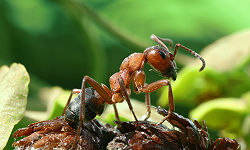| Part of a series on the |
| Wildlife of Great Britain |
|---|
 |
This is a list of ants of Great Britain, including endemic and introduced species. Compared with much of the rest of Europe, Great Britain has a smaller number of ants. The size and diversity of ant species in any area is largely determined by the highest summer soil temperature, and this being so, it is not surprising that the greatest concentration of different species is centred in the warmer parts of the country – Dorset, Hampshire, Surrey, the Isle of Wight and Kent being the 5 richest counties, with 33, 31, 29, 27 and 26 different species present respectively.
Contents
A few species, best exemplified by Lasius niger and Myrmica rubra , are truly cosmopolitan, colonising a great variety of different habitats (often including those directly resultant from human activities). These species are very common in most places, and have ranges that cover most of the nation.
The larger part of Great Britain's ant species are, however, considerably more specialised in their requirements. Most independent species are found on undisturbed heathland in the south – probably as a direct result of its superior summer soil temperatures – and six are entirely dependent on other species during their mature life (i.e. not simply to found colonies, a requirement of many further species).
Many of the lesser seen species are at the northern extent of their range in Britain, and for this reason are confined to the south. The variously differing biotopes afforded by parkland / partially wooded heath and larger traditional style gardens are also inhabited by a number of otherwise more heathland-pigeonholed species, such as Formica fusca/lemani, Lasius mixtus/umbratus and L. fuliginosus.
The remaining species are mostly sylvan. These include the well known wood ants, typified by the southerly inclined Formica rufa , and the more northerly F. lugubris and F. aquilonia. These large, noticeable species abide in mounds constructed from leaf litter, which are still a common sight in many older forests and broken woodland up and down the country. A few other smaller, less easily spotted species also make their livings in conjunction with more wooded areas. Stenamma species, Leptothorax acervorum and Temnothorax nylanderi can be found, locality permitting, under stones/logs and beneath loose bark respectively, in established woods. The former habitat is also shared by the rather locally distributed Ponera coarctata, one of two unambiguously native British representatives of the subfamily Ponerinae. The other is the recently discovered P. testacea, which inhabits xerothermic sites.
The list largely follows Skinner & Allen's Naturalists' Handbooks 24 : Ants published in 1996, [1] though there have been some additions and corrections. Introduced species are marked with an asterisk (*).


